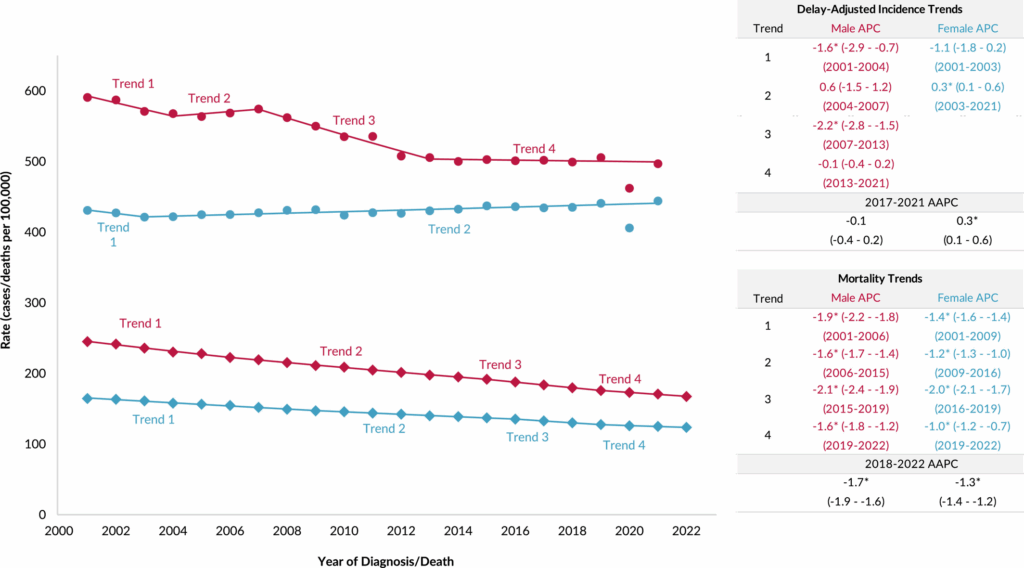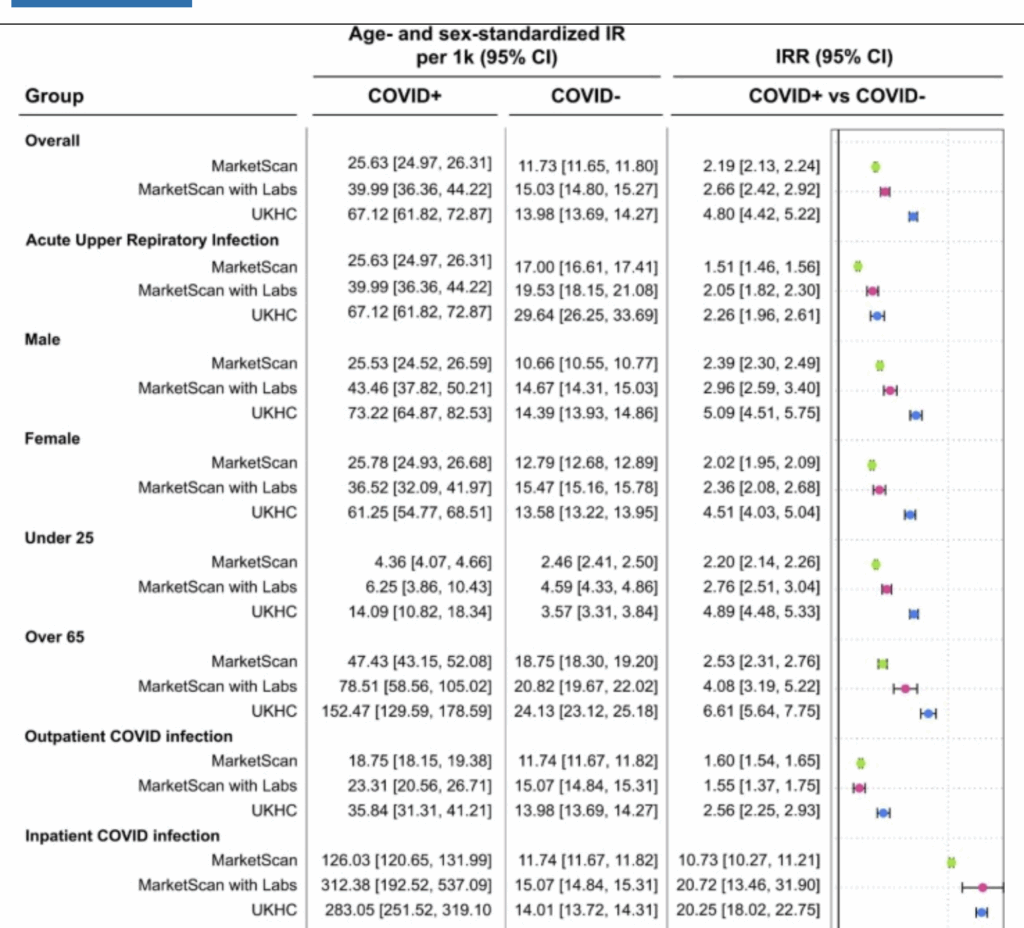COVID-19
Transmission
In the 2024-04-04 BC post, I said that I had figured out why the COVID-19 levels were so low right now: because influenza inhibits COVID-19! Aha!
Well, that’s bullshit. I don’t have good data going back a long time for flu in BC, but this chart of flu, COVID-19, and RSV levels from the UK from this blog shows that it is quite possible to have high levels of COVID-19 and influenza simultaneously. Ooops. Sorry.
I’m back to having only weak explanations for why COVID-19 is so low in BC (and many jurisdictions) right now.

☠️🐁🤮 Ewww. This paper (2025-04-21) reports that dead mice had infectious SARS-CoV-2 virus in them for several days after they died. Mouse cadavers which sat around at room temperature (ewww!) had infectious SARS-CoV-2 for five days; refrigerated mice had infectious virus for seven days. (By contrast, RSV in dead mice only stayed infectious for a day or two and influenza only for a few hours.)
Pandemic Side Effects
🦀 This paper from USA (2025-04-21) reports that cancer diagnoses went down in 2020,
- but mortality wasn’t affected, and
- diagnoses bounced right back up in 2021.
Note how the cancer diagnoses trend line (upper two lines) has two dots way off of the trend line for 2020, but the mortality trend lines (lower two lines) progress calmly through 2020 like it’s no big deal.

(Side note, not COVID-19: I thought it was interesting that men have higher rates of cancer diagnosis and mortality than women. I had expected the reverse, since women have a LOT of breast, cervical, and ovarian cancer and men, well, don’t. This web page says that men die from colon cancer about 30% more than women do, and about three times as often from bladder cancer. Maybe because they have larger bladders, the urine sits in the bladder for longer, and over time that is bad for the bladder tissues?)
🤓 This paper from Israel (2025-04-23) found that kindergartners who were tested in 2023 had three times the rate of nearsightedness as ones who were tested pre-pandemic. I am not particularly surprised because there are a lot of studies which show that myopia is worse if you don’t get a lot of bright light as a kid. (See this review article (2019-07-21).) There’s a theory that bright light stimulates release of a specific hormone which inhibits elongation of the eye (which leads to nearsightedness).
🇮🇱 The Wikipedia page on the pandemic in Israel says that there were significant movement restrictions for about nine months. Were these restrictions enough to decrease the amount of time kids spent outdoors? Hard for me to tell. Maybe the myopia was a direct result of getting a COVID infection, in which case this summary ought to be in the Pathology section.
This paper from Netherlands (2025-01-17) reported that young children tested at some face-processing tasks during periods of COVID-19 mitigation measures (“pandemic children”) differed from those of children tested pre-pandemic (“controls”). They did this by measuring brain waves the children generated in response to pictures of faces and houses.
- 3 y/o pandemic children (but not infants or 10 month old children) recognized faces (as opposed to houses) faster than controls;
- the pandemic children of all ages (3 y/o, 10 month olds, and infants) did not recognize a difference between happy faces and fearful faces. The pandemic children’s reaction to happy faces was weaker than the controls’ reaction; both groups had similar reactions to fearful faces.
The conclusion that my snarky brain immediately moved to was that people weren’t happy during the pandemic, so the kids didn’t see many happy faces.
Long COVID
This paper from Thailand (2025-04-25) reports that 15.6% of children who had COVID-19 still had symptoms 1-3 months after the acute illness, while only 1.1% of children with other infections had lingering symptoms.
They also reported that 20.4% (by the CDC definition) and 13.0% (by the WHO definition) of the children who’d had COVID-19 had Long COVID.
COVID-Related Excess Death and Sickness
🍆🥛 AGAIN This paper from Brazil (2025-04-26) reports that SARS-CoV-2 was found in semen of more than half of the participants, and for at least eight months post-infection in almost half of them. While sperm quality dropped initially, it recovered by the six-month mark.
This paper from USA (2025-04-19) reports that diabetes or incipient diabetes (i.e. had lab tests like high A1C which strongly suggest diabetes) is much more common in people who had COVID-19 and much much more common in people for hospitalized patients than outpatients. The risks for people who had had COVID-19 infections varied by subgroup and which of three large datasets they used, but were between 2x and 6x the risk of controls for outpatients. For people hospitalized with COVID-19, the risk of diabetes or incipient diabetes was between eleven and twenty-one times higher than for people who were COVID-negative.

Treatments
💊🎉 This paper from Taiwan (2025-04-21) reports that patients taking Paxlovid while they were actively (“acutely”) sick reduces strokes and death a long time later. After 90 days post-acute phase, adults over 18 who took Paxlovid during acute COVID-19, compared to non-Paxlovid-taking controls were 15% less likely to have ischemic and hemorrhagic stroke and 32% less likely to die. (Older adults who took Paxlovid did even better, but I can’t give specifics because that part of the paper is paywalled.)
Pathology
🦶This paper from Switzerland (2025-04-14) reports that chilblains/”COVID toes” are a side effect of a highly active innate immune system. The authors say that people who got COVID-19 toes usually had asymptomatic or extremely mild cases of COVID-19. Huh.
Mitigation Measures
😷 This paper (2025-04-21) reports on actual measurements of various types of masks. They found that filtration efficiency (FE) of particles 0.02–1 µm in size, without fit testing, was as follows:
| Mask type | FE |
| cloth mask with earloops | 47 ± 5% |
| double cloth masks with both using earloops | 47 ± 5% |
| cloth mask with overhead ties | 55 ± 6% |
| double cloth mask with overmask using overhead ties | 66 ± 6% |
| level 1 masks | 56 ± 9% |
| level 1 masks with cloth-overhead-ties overmask | 84 ± 10% |
| level 1 masks with silicone or Fix-the-Mask brace | 87–91% |
| level 3 masks | 70 ± 13% |
| level 3 masks with cloth-earloops overmask | 84 ± 13% |
| level 3 masks with cloth-overhead-ties overmask | 92 ± 3% |
| level 3 mask with brace | 92–94% |
| non-certified KN95 look-alike | 57-77% |
| two different KF94s | 57-77% |
| three KN95s | 57-77% |
| N95 | 97-98% |
| CaN99 | 97-98% |
The cloth mask they tested was the “Essex” pleated mask type.
Wearing ear guards (which I think are these things), scrub cap, or by knot-and-tuck didn’t change the FE for L1 or L3 masks (“baggy blues”).
The authors specifically called attention to the fact that a well-fitting cloth mask has filtration comparable to an L1 mask. Apparently the better edge seal of the cloth masks makes up for the leakier fabric.
The authors also called attention to how the N95s and CaN99s were significantly better than the KN94/5s. They tested the material and the material was fine, so it must be the fit. KN94-style have earloops while the N95-type has overhead straps. This is consistent with this paper (2021-05-18) which I talked about in the 2025-03-15 General post which said that overhead straps were way better than earloops (for beared men, true but it probably tracks).
I was surprised at how effective the L1 and L3 masks were. 56 ± 9% isn’t that great, but it’s a whole lot better than zero.
☠️ This paper (2025-04-22) tried to tease out what factors were responsible for wildly different excess death rates in different countries during at the beginning of the pandemic. The biggest factor, they found, was the strength of the Rule of Law. They were surprised that CO2 emissions and population density did not correlate with excess deaths, and that greater healthcare system capacity was associated with higher mortality. They also found that specific policies did not affect mortality; they suspect that what matters is not what the policy is but what people actually do.
Pathology
This press release from the Hong Kong public health agency (2025-04-23) says that a baby girl with “good past health” is in the ICU with a co-infection of COVID-19 and human metapneumovirus. It is rare, but some kids do get hospitalized with just COVID-19, so I don’t know if this is just a COVID-19 thing or if the human metapneumovirus is making it much worse. They probably don’t know either. (You might not have heard of human metapneumovirus, but it is common enough that BC includes it in their standard respiratory pathogens report. It’s “a cold”.)
👩🍼 This paper from Russia (2025-04-23) reports that babies whose mothers had COVID-19 during pregnancy had lower diversity in their gut microbiomes than babies whose mothers dodged COVID-19 in pregnancy.
Vaccines
💨 Know anyone in Hamilton or Halifax? McMaster University is looking for people in Hamilton and Halifax to test their inhaled COVID-19 vax.
💉 This press release from Novavax (2025-04-23) seems to be saying, “The FDA said they wanted us to promise-cross-our-heart-hope-to-die to give them some more data on our latest vax after they approve us. This is bullshit — we gave them everything they needed the first time — but sure, we’ll give them more data later.” But this later article (2025-04-25) says that by “more data” the government means “a whole new random clinical trial” (which would cost millions of dollars). WTF, FDA? What was wrong with the last one?
There are legit injuries you can get from vaccines. Guillain-Barré syndrome (GBS) is very rare but very nasty thing that sometime happens after infections. However, this study from Israel (2023-11-14) reports that based on an electronic records search of a cohort of more than three million adults reports, the risk of GBS was 6.3 time higher if you had a COVID-19 infection than if you didn’t, while the risk of GBS was 59% lower if you had a COVID-19 vaccine than if you didn’t.
Recommended Reading
At one level, I don’t care if COVID-19 has a wet market origin or a lab leak origin. That has never been as important to me as “what do we do about it now?” However, I find the White House’s pushing the lab leak theory of the story to be kind of scary, so as a counter: this long read (2025-04-11) explains pretty persuasively (although also somewhat indirectly) why the wet market theory is more likely.
H5N1
Transmission
🐄 This article (2025-04-25) reports that there have now been 1031 dairy herds in the USA infected with H5N1.
Mpox
Vaccines
This paper from USA (2025-04-24) reports that 58% of people surveyed in 2025 in the USA would get an mpox vaccine if it were recommended by their doctor or health authority. The bad news: 42% would not. The good news: the percentage who would get a shot is increasing — in 2022 only 12% fewer said they would get a vax.
Ebola
🎉🎉🎉 This article (2025-04-25) reports that it looks like Uganda’s Sudan Virus (an Ebola relative) outbreak is over!
Measles
Transmission
Yeah, this article (2024-04-25) reports that measles is still happening in the USA.
The Canada weekly measles and rubella monitoring report (with data through 2025-04-12) says that measles is still happening in Ontario (120 new cases in the most recent week of data) and Alberta (60 new cases). BC had one new case in the most recently reported week of data.

1 comment
Comments are closed.